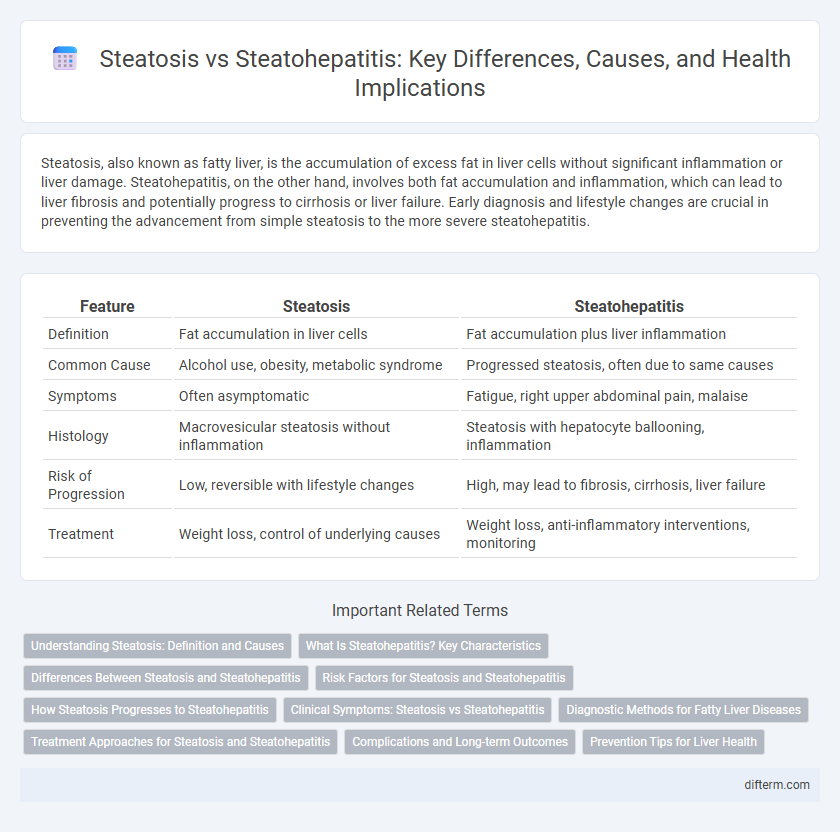Steatosis, also known as fatty liver, is the accumulation of excess fat in liver cells without significant inflammation or liver damage. Steatohepatitis, on the other hand, involves both fat accumulation and inflammation, which can lead to liver fibrosis and potentially progress to cirrhosis or liver failure. Early diagnosis and lifestyle changes are crucial in preventing the advancement from simple steatosis to the more severe steatohepatitis.
Table of Comparison
| Feature | Steatosis | Steatohepatitis |
|---|---|---|
| Definition | Fat accumulation in liver cells | Fat accumulation plus liver inflammation |
| Common Cause | Alcohol use, obesity, metabolic syndrome | Progressed steatosis, often due to same causes |
| Symptoms | Often asymptomatic | Fatigue, right upper abdominal pain, malaise |
| Histology | Macrovesicular steatosis without inflammation | Steatosis with hepatocyte ballooning, inflammation |
| Risk of Progression | Low, reversible with lifestyle changes | High, may lead to fibrosis, cirrhosis, liver failure |
| Treatment | Weight loss, control of underlying causes | Weight loss, anti-inflammatory interventions, monitoring |
Understanding Steatosis: Definition and Causes
Steatosis, commonly known as fatty liver, is characterized by the accumulation of excess fat in liver cells, primarily caused by obesity, insulin resistance, and excessive alcohol consumption. This condition disrupts normal liver function and can be triggered by metabolic syndrome, type 2 diabetes, and high cholesterol levels. Understanding the underlying causes of steatosis is essential for preventing progression to more severe liver diseases such as steatohepatitis.
What Is Steatohepatitis? Key Characteristics
Steatohepatitis is a severe form of fatty liver disease characterized by inflammation and liver cell damage alongside fat accumulation in the liver. Unlike simple steatosis, steatohepatitis involves hepatocyte ballooning and varying degrees of fibrosis, increasing the risk of cirrhosis and liver failure. Key biomarkers include elevated liver enzymes such as ALT and AST, with diagnosis often confirmed through liver biopsy and imaging techniques.
Differences Between Steatosis and Steatohepatitis
Steatosis, commonly known as fatty liver, involves the accumulation of fat in liver cells without significant inflammation, whereas steatohepatitis includes both fat accumulation and inflammation, leading to liver cell damage. The key difference lies in the presence of inflammation and hepatocellular injury in steatohepatitis, which increases the risk of fibrosis and progression to cirrhosis. Diagnosing steatohepatitis typically requires liver biopsy to assess inflammation and fibrosis, unlike steatosis which can often be identified through imaging and blood tests.
Risk Factors for Steatosis and Steatohepatitis
Risk factors for steatosis include obesity, insulin resistance, type 2 diabetes, and excessive alcohol consumption, which lead to fat accumulation in liver cells. Steatohepatitis risk factors extend to the same conditions as steatosis but also involve inflammation triggers such as oxidative stress, mitochondrial dysfunction, and genetic predisposition, increasing liver injury severity. Chronic metabolic syndrome and high-fat diets significantly contribute to the progression from simple steatosis to steatohepatitis.
How Steatosis Progresses to Steatohepatitis
Steatosis, characterized by the accumulation of fat in liver cells, progresses to steatohepatitis when fat-induced lipotoxicity triggers inflammation and hepatocellular injury. Oxidative stress and mitochondrial dysfunction amplify cellular damage, promoting the release of pro-inflammatory cytokines and recruiting immune cells to the liver tissue. This transition marks the shift from simple fatty liver to a more severe condition involving inflammation and fibrosis, increasing the risk of cirrhosis and liver failure.
Clinical Symptoms: Steatosis vs Steatohepatitis
Steatosis often presents with mild or no symptoms, typically identified through imaging or elevated liver enzymes without significant discomfort. In contrast, steatohepatitis manifests more severe clinical symptoms such as fatigue, right upper abdominal pain, and elevated inflammatory markers, reflecting liver inflammation and damage. Recognition of these symptomatic differences is crucial for early diagnosis and management of progressive liver disease.
Diagnostic Methods for Fatty Liver Diseases
Ultrasound imaging serves as a primary diagnostic tool for detecting steatosis by revealing increased liver echogenicity, while transient elastography measures liver stiffness to distinguish simple steatosis from steatohepatitis. Blood tests, including alanine aminotransferase (ALT) and aspartate aminotransferase (AST) levels, aid in identifying inflammatory activity characteristic of steatohepatitis. Liver biopsy remains the gold standard, providing definitive histological assessment to differentiate benign steatosis from progressive steatohepatitis and fibrosis.
Treatment Approaches for Steatosis and Steatohepatitis
Treatment approaches for steatosis primarily involve lifestyle modifications such as weight loss through diet and exercise, along with managing underlying conditions like diabetes and hyperlipidemia. Steatohepatitis, characterized by liver inflammation, often requires more intensive interventions including pharmacologic therapies like vitamin E or pioglitazone, particularly in nonalcoholic steatohepatitis (NASH). Monitoring liver function and regular imaging are crucial in both conditions to assess disease progression and treatment efficacy.
Complications and Long-term Outcomes
Steatosis primarily involves fat accumulation in liver cells without significant inflammation, whereas steatohepatitis includes liver inflammation and damage, increasing risks of fibrosis, cirrhosis, and hepatocellular carcinoma. Complications of steatohepatitis progress more rapidly, leading to higher incidences of liver failure and liver-related mortality compared to simple steatosis. Long-term outcomes for steatohepatitis often require more intensive medical interventions, including potential liver transplantation, reflecting its more severe impact on liver health.
Prevention Tips for Liver Health
Maintaining a balanced diet rich in antioxidants, limiting alcohol consumption, and engaging in regular physical activity are essential for preventing both steatosis and steatohepatitis. Monitoring blood sugar levels and controlling obesity significantly reduce the risk of fat accumulation and liver inflammation. Routine liver function tests help detect early signs of liver damage, enabling timely lifestyle adjustments to preserve liver health.
Steatosis vs Steatohepatitis Infographic

 difterm.com
difterm.com